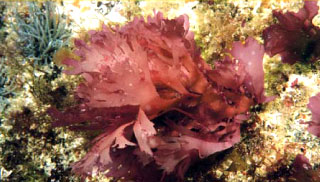News
The Key Ingredient
A commonly found and inexpensive ingredient in many food and lubricant products—carrageenan—may protect women from HPV infection.

Gelatinous extracts called carrageenans that come from the Chondrus crispus red seaweed—commonly used as food additives and in lubricants—may have anti-HPV properties. (Photo: iStockphoto.com)
Virtually all cervical cancers are caused by persistent human papillomavirus (HPV) infections, the most common sexually transmitted infection in young adults. According to the World Health Organization, cervical cancer is the second leading cause of female cancer deaths worldwide. But despite significant advances in the fight against HPV, many women are not yet reaping the benefits. HPV vaccines, for example, are too expensive for most women in developing countries. However, a safe, reliable, and inexpensive topical microbicide could protect women around the world from HPV infection and its potentially deadly consequences.
Recent studies have shown that the common, low-cost gelling agent carrageenan (found in many food products) is an extremely potent inhibitor of HPV infection in vitro and in animal challenge models. Retrospective clinical data announced at the 2010 International Papillomavirus Conference held in Montreal, Canada, indicated that a carrageenan-based personal lubricant called Carraguard, developed by The Population Council, is effective for preventing HPV infection in women.
Chris Buck, Ph.D., Head of the Tumor Virus Molecular Biology Section at CCR, had more than a passing interest in these findings when he first learned of them. Dr. Buck did much of the pioneering basic research to first identify carrageenan as an HPV entry inhibitor. He began his research under CCR mentors John Schiller, Ph.D., and Douglas Lowy, M.D., investigating HPV entry into cells and screening compounds that might interfere with that process. “I actually ended up testing some food additives just out of curiosity, and carrageenan has long been known to look chemically similar to the known primary attachment receptor for HPV, heparan sulfate,” said Dr. Buck. “Carrageenan was so powerful that I had to do the experiment three times, each time diluting more and more because I was getting 100 percent inhibition.”
Making the connection between its therapeutic potential and its gelling properties, Dr. Buck determined that carrageenan was found in several personal lubricant products. “The reason I’m so excited about the clinical data is because I think it’s conceivably a cheap and easy method for women to protect themselves,” said Dr. Buck. As with Carraguard, he believes the use of other carrageenan—based personal lubricants—such as Divine No 9, BIOglide, or Oceanus Carrageenan—may also prevent HPV infection. Prospective trials are now under way to give a clearer picture of carrageenan’s efficacy against HPV, including trials with HPV typing and sampling at the start of the trial.
Although Dr. Buck’s research has moved beyond topical microbicides, he and Dr. Schiller still support the development of carrageenan trials by testing candidate preparations and placebo controls to make sure the best possible candidates enter the trials. “We’re sort of cheerleaders and we do some of the basic science bench work to support those trials,” said Dr. Buck. “And we’re excited because we had already gotten to the point where we felt it was okay to tell people that if they were already using a lubricant product, they might as well choose one that has carrageenan in it because—who knows—maybe it would help. And that recommendation is even more legitimate now.”
To learn more about Dr. Buck’s research, please visit his CCR Web site at http://ccr.cancer.gov/staff/staff.asp?Name=buckc.












